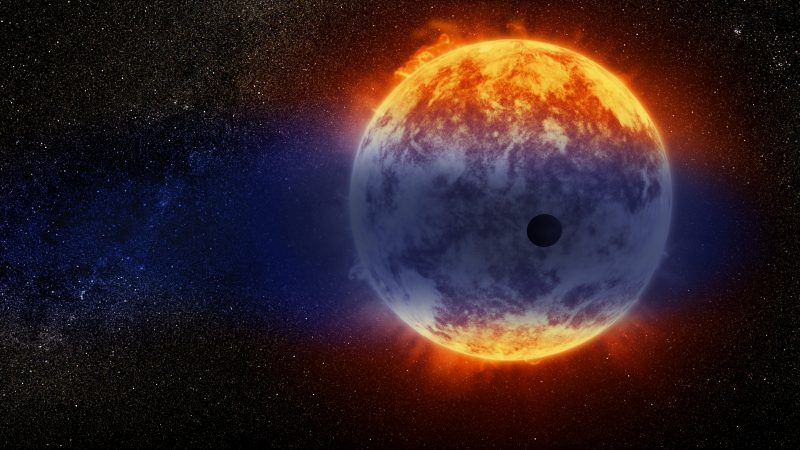
How long can planets live? At least in part, the answer may depend on how far away a planet is from its star. In recent years, astronomers have begun finding a type of planet – which they call warm Neptunes – observed to be “evaporating” into space. The planet may be losing its atmosphere. Or the mass of the planet itself may be being lost. Basically, these planets are gradually shrinking and vanishing from existence. Two such worlds have been discovered so far.
One planet discussed before was GJ 436b, but now another similar world has been discovered that is evaporating at a rate 100 times faster – GJ 3470b. The peer-reviewed findings were published in the journal Astronomy & Astrophysics on December 13, 2018.
According to David Sing, a Bloomberg Distinguished Professor at Johns Hopkins and an author on the new study:
This is the smoking gun that planets can lose a significant fraction of their entire mass. GJ 3470b is losing more of its mass than any other planet we seen so far; in only a few billion years from now, half of the planet may be gone.
The discovery was made as part of the Panchromatic Comparative Exoplanet Treasury (PanCET) program. The purpose of PanCET is to measure the atmospheres of 20 different exoplanets in ultraviolet, optical and infrared light, using the Hubble Space Telescope.

Other planets have also been observed losing their upper atmospheres, such as “hot Jupiters” and “super-Earths” that orbit very close to their stars. Since they are much hotter than planets farther away, their atmospheres can be blown off into space. They are also more common, at least among observed exoplanets, than Neptune-sized worlds.
Hubble found that GJ 3470b had lost significantly more mass and had a noticeably smaller exosphere than the first Neptune-sized exoplanet studied, GJ 436b. This is thought to be due to its lower density and the stronger radiation blast it receives from its host star. It is estimated that GJ 3470b may have already lost 35 percent of its original mass. A few billion years from now, all that may remain is a small rocky core. As Sing explained:
We’re starting to better understand how planets are shaped and what properties influence their overall makeup. Our goal with this study and the overarching PanCET program is to take a broad look at these planets’ atmospheres to determine how each planet is affected by its own environment. By comparing different planets, we can start piecing together the larger picture in how they evolve.
Also, the parent star of GJ 3470b is only 2 billion years old, compared to the 4-billion to 8-billion-year-old star that planet GJ 436b orbits. The younger star is more energetic, so it blasts the planet with more intense radiation than GJ 436b receives. Both are red dwarf stars, which are smaller and longer-lived than our own sun, and red dwarfs are known for being very active, with frequent bursts of solar flares.

It is a significant discovery, according to lead researcher Vincent Bourrier of the University of Geneva in Sauverny, Switzerland:
I think this is the first case where this is so dramatic in terms of planetary evolution. It’s one of the most extreme examples of a planet undergoing a major mass-loss over its lifetime. This sizable mass loss has major consequences for its evolution, and it impacts our understanding of the origin and fate of the population of exoplanets close to their stars.
These findings suggest that warm Neptunes may have started off as “hot Neptunes” – a transitory kind of planets which tend to shrink down over time to become mini-Neptunes. Those worlds are larger than Earth but smaller than Neptune, and have heavy, hydrogen-dominated atmospheres. They may then continue to shrink to become super-Earths – rocky like Earth but more massive. According to Bourrier:
The question has been, where have the hot Neptunes gone? If we plot planetary size and distance from the star, there’s a desert, a hole, in that distribution. That’s been a puzzle. We don’t really know how much the evaporation of the atmospheres played in forming this desert. But our Hubble observations, which show a large amount of mass loss from a warm Neptune at the edge of the desert, is a direct confirmation that atmospheric escape plays a major role in forming this desert.
While it is primarily hydrogen that is being lost to space, other trace gases may be as well, and researchers plan to use Hubble to search for those too, according to Bourrier:
We think that the hydrogen gas could be dragging heavy elements such as carbon, which reside deeper in the atmosphere, upward and out into space.

Astronomers want to observe other similar warm Neptunes, but unfortunately GJ 3470b and GJ 436b may be the only ones close enough. With current technology, hydrogen can’t be detected in warm Neptunes farther than 150 light-years away. Helium, however, can be detected at those distances – by both Hubble and the upcoming James Webb Space Telescope (JWST) – as noted by Bourrier:
Looking for helium could expand our survey range. Webb will have incredible sensitivity, so we would be able to detect helium escaping from smaller planets, such as mini-Neptunes.
As reported recently on EarthSky, astronomers did just discover that another exoplanet – HAT-P-11b – is losing its helium atmosphere to space in a similar manner and is “inflated like a helium balloon.” HAT-P-11b is just a little larger than Neptune, 124 light-years away.
Bottom line: Warm Neptunes may not be all that common, but the fact that two of them have now been found to be “evaporating” as their hydrogen atmospheres leak away into space provides valuable clues as to how they may evolve eventually into mini-Neptunes and super-Earths over billions of years.
EarthSky lunar calendars are cool! They make great gifts. Order now. Going fast!











